Project cycle management (PCM) is a project management approach that addresses the complexities of a project through all of its phases while maintaining alignment with the strategy and objectives agreed upon by stakeholders at the onset.
PCM helps with structuring and determining the phases of the project and how to approach tasks in those phases. It also assists in planning and review and can be used when managing multiple projects.
Project cycle management is a methodology that’s commonly used for larger projects that involve multiple stakeholders and significant human and material resources, which is why they require a robust project management solution like ProjectManager. ProjectManager is an award-winning project management software that offers a variety of tools to plan, schedule and monitor projects such as online Gantt charts, dashboards, timesheets and advanced resource planning and cost-tracking features. Get started today for free.
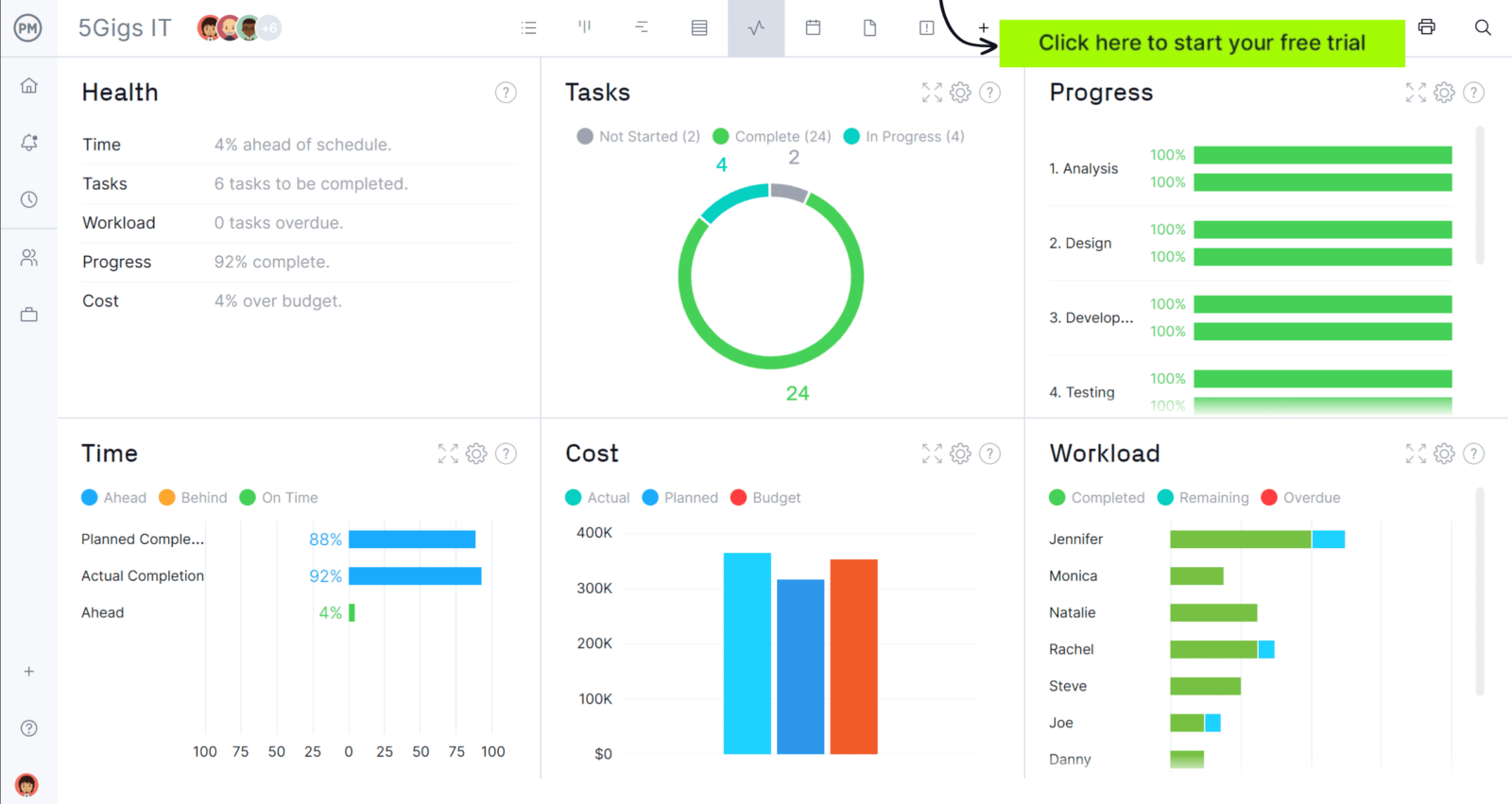
What Is Project Cycle Management?
Project cycle management is a methodology for managing projects. It provides structure to the process, but also includes consulting stakeholders and providing them with relevant information throughout the life cycle of the project. This helps inform the best possible decisions.
The cycle of management operations within project cycle management is broken up into six phases:
- Programming: The programming phase asks what the developmental priorities are and comes to an agreement of a strategy paper and indicative program.
- Identification: The identification phase there needs to be the completion of the fiche, or financing proposal, after a delegation makes an initial assessment. The proposal is then accepted, modified or denied, and financing is committed or not.
- Formulation or Planning: The formulation phase determines if the project is feasible and if it will deliver on the benefits it proposes by completing the financing proposal, along with technical and administrative provisions.
- Implementation: If results are being achieved and resources are being used properly, there is a submission of an annual operating plan, as well as other monitoring reports and reviews to determine if financing needs to continue as planned or change to support new needs.
- Monitoring and Evaluation: Evaluation determines if the project achieved its planned goals by completing an evaluation study, which is planned and managed by a task manager.
- Closing: During the closing phase, an audit is conducted to determine if the project was completed in compliance with law and rules, and if other criteria have been met. The process is usually managed by an audit task manager.
This cycle highlights decision-making criteria and procedures, which are defined at each specific phase. The phases themselves are progressive (each needing completion before moving on to the next), and new projects are informed by the results of the final phase: evaluation and audit.
The European Union (EU) uses project cycle management to make sure that it funds projects that are aligned with its objectives. The European Commission adopted project cycle management in 1992 as its primary set of project design and management tools.
Who Uses Project Cycle Management?
From government agencies to academic institutions, many entities can benefit from using project cycle management. Below are only some examples.
Government Agencies
Government agencies can use project cycle management in various ways, such as ensuring public resources are used efficiently, aligning projects with policy objectives and maintaining overall accountability. Through data analysis and stakeholder consultations, government agencies can identify social needs to ensure their projects align with public priorities. PCM is commonly used in public health initiatives and infrastructure projects.
Non-Government Organizations (NGOs)
NGOs can utilize project cycle management to ensure their resources are optimized and that their projects align with both mission and donor requirements. It’s typical for these types of projects to start with a needs assessment that looks at the target communities to help pinpoint the most pressing challenges and develop solutions. PCM is commonly used in NGO projects such as education, healthcare and humanitarian relief.
Donor Organizations
Another entity that may use PCM is donor organizations. They use it to monitor the projects they fund to ensure that projects are executed according to their objectives and are meeting their impact metrics. Donor organizations keep a close eye on the project effectiveness, sustainability and scalability as they need to replicate projects in multiple communities or territories.
Project Cycle Management Phases
We mentioned that project cycle management is made up of six phases, so let’s dig deeper into each phase and cover their actual implementation.
1. Programming
The programming phase is when the negotiations take place, which leads to an agreed process documented in an indicative program. The process is meant to identify the main objective of the project and what its priorities are, which creates a relevant and feasible framework for the project.
Past projects are researched to provide precedent and direction for future ones. This process is usually multi-annual and not directly relevant to an individual project, though it’s important for each project to be aware of high-level strategy.
Key Outcomes from the Programming Phase
The main outcome from the programming phase is an alignment of funding goals and strategic priorities that speak to broader organizational needs. There should also be an initial resource allocation and funding strategy.
Programming Phase Documentation
Documentation may include technical documentation like strategic plans or frameworks. It could also include budget and funding allocation plans or a context analysis and needs assessment reports.
2. Identification
The identification phase analyzes the relevance of the project proposals. This includes the stakeholders and target group of the project. It analyzes potential problems these parties might have and what options there are to address and resolve them.
During this phase, many studies are carried out to help identify these ideas and define what actions should take place. All of this will be then collected in a project identification report, which explains the reasons behind the decisions made. This phase is directly relevant to the project, as the project’s structure will be determined at this point.
Key Outcomes from the Identification Phase
These include a clear definition of the problem or need and a prioritization of project ideas that align with strategic objectives.
Identification Phase Documentation
Includes a problem statement or concept notes, needs assessment reports, an initial risk assessment and a stakeholder analysis.
3. Formulation
The formulation phase, with the identification phase, is the financing decision-making part of the project cycle management process. During this phase, a quality assessment of the financing proposal is undertaken. Any changes that are recommended to that draft are then applied to the financial proposal, which is either approved or rejected by the competent authority.
If the project is approved, next comes the preparation, negotiation and signing of a financial agreement, which includes the necessary technical and administrative provisions to start the project.
Key Outcomes from the Formulation Phase
Outcomes in this stage include a detailed project design that has activities, objectives, timelines and resource requirements. It should also include a finalized budget and resource plan.
Formulation Phase Documentation
In this stage of project cycle management, documentation includes a detailed project project proposal or design document. It should also include a risk management plan, work breakdown structure and a stakeholder engagement plan.
4. Implementation
Now that the project has been planned and financed, it’s time to implement it. This can be a long process, sometimes years, depending on the project, and includes three periods: the start-up period, the main implementation period and the closure period.
Throughout the implementation there can be re-planning as schedules and budgets are reviewed, refined and updated. Monitoring and reporting also occur during this phase, establishing controls to make sure that the project remains on track. Reports are now generated to provide data on the project’s progress.
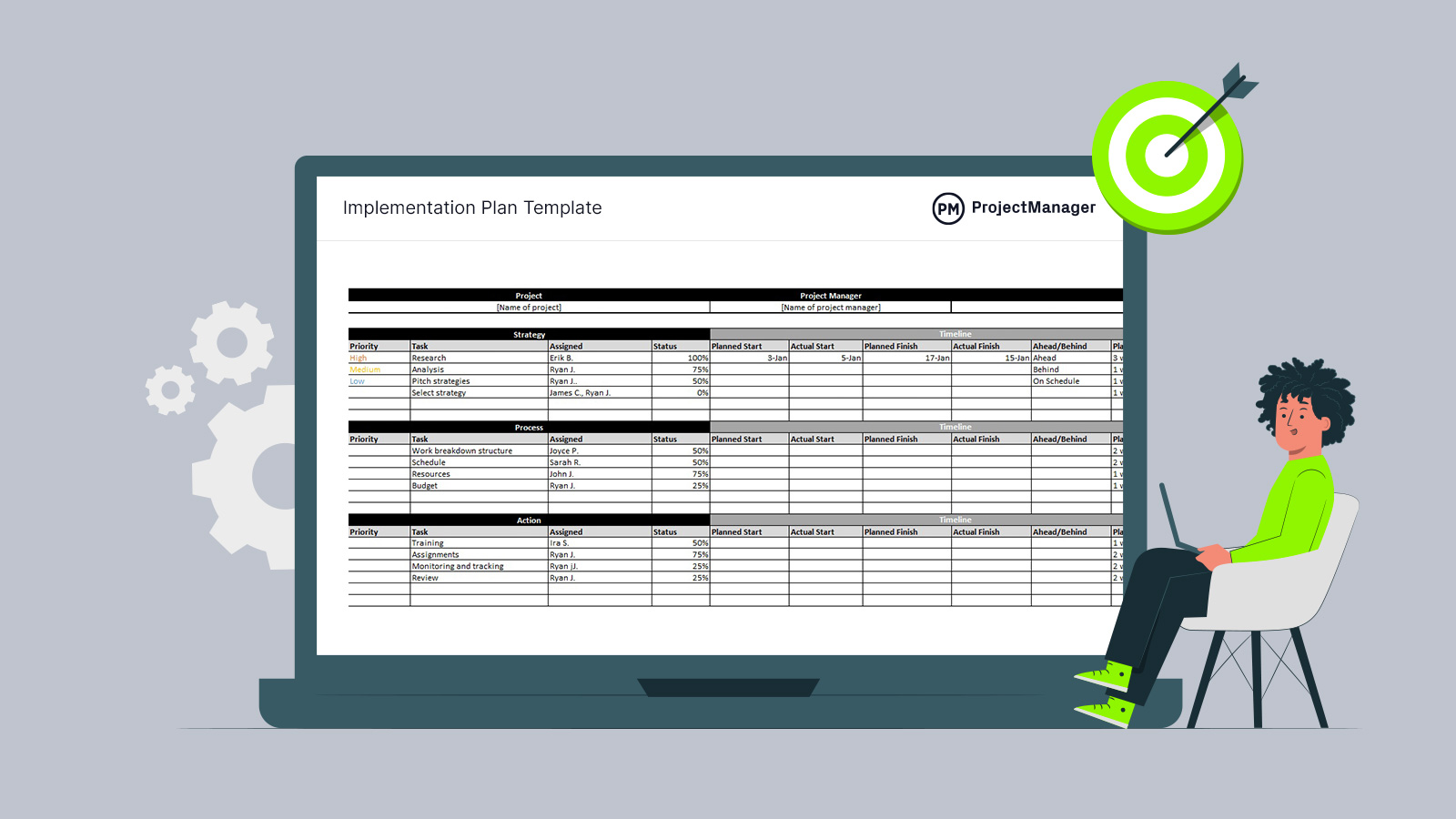
Get your free
Implementation Plan Template
Use this free Implementation Plan Template for Excel to manage your projects better.
Key Outcomes from the Implementation Phase
Outcomes include achieving the project activities and deliverables.
Implementation Phase Documentation
Documentation for this stage includes an implementation plan, financial reports, activity progress reports, stakeholder communication logs and monitoring reports.
5. Monitoring and Evaluation
The project has officially kicked off so now is the time to track it systematically. During this stage of project cycle management, the project’s performance will be assessed and any needed changes will be made to ensure that its objectives are met.
Key activities include collecting and analyzing project data, assessing the effectiveness and impact of the project, tracking key performance indicators and maximizing the project’s impact on beneficiaries.
Key Outcomes from the Monitoring and Evaluation Phase
Outcomes include insights into how the project is progressing and performing. Evidence-based adjustments can be made.
Monitoring and Evaluation Phase Documentation
Project management reports and dashboards are helpful during this phase as well as lessons learned documents and stakeholder feedback records.
6. Completion and Closure
Last but not least comes the completion and closure phase. It involves a formal ending to the project to ensure a smooth transition to the next phase, which could be another project or ongoing operations.
Project managers can use this phase to ensure the project meets its objectives and delivers value. If the project has lessons learned, they can be captured during this time to improve future projects.
Key Outcomes from the Completion and Closure Phase
The final project outputs will be delivered and assessed against the project objectives.
Completion and Closure Phase Documentation
Documentation in this project cycle management phase includes a final project evaluation report and handover and acceptance documents.
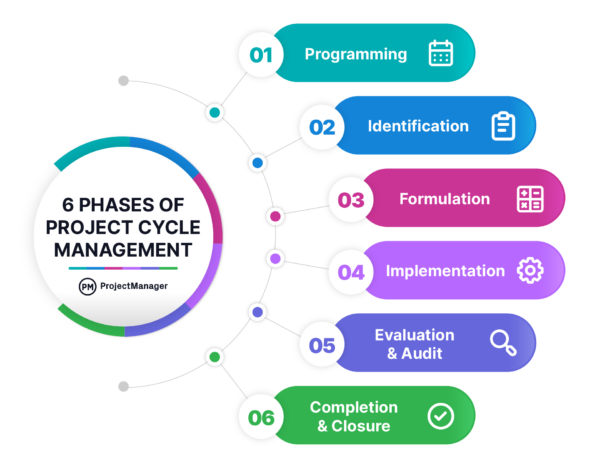
Why Implement the Project Cycle Management Approach?
Project cycle management keeps projects within the policy objectives of the organization that initiated the project. It also helps projects stay relevant to the strategy that had been agreed upon, along with the needs of stakeholders and/or customers.
Project cycle management also ensures that the project itself is feasible. Through cycle management, projects are protected from wasting valuable resources by deciding if they can be realistically achieved and are worthwhile before execution, as well as noting if the benefits of the project are sustainable.
To do all this, project cycle management requires that stakeholders participate. It also requires the use of the logical framework approach and other tools to support the process. There is also an incorporation of quality assessment criteria and documentation at each stage of the project.
Benefits of Project Cycle Management
Project cycle management provides many benefits as it provides a structure approach to project planning, execution and evaluation. Here are only some of them.
Ensures Project Strategic Alignment
Because of the robust planning that’s needed for project cycle management, it’s easier to align project objectives with overarching organizational goals. Progress is closely monitored throughout each phase which makes it easier to stay on track and take corrective action as needed.
Focuses on Stakeholder Engagement
Stakeholder involvement is integral to every phase of project cycle management. If there are changes to be made, they can be quickly identified and addressed. Active participation from stakeholders helps reduce risk and keeps the project aligned with stakeholder priorities.
Iterative Approach Facilitates Change Management
One of the key strengths of PCM is its ability to respond to risks and changes. It includes continuous monitoring and feedback throughout the project instead of solely at the end. This makes it easier to manage changes as they appear, mitigating risks and addressing performance issues along the way. Once the project is done, any lessons learned can be applied to future projects to improve the change management process.
How ProjectManager Helps With Project Cycle Management
Project cycle management is one more gear moving concurrently within the larger machine of a project. Therefore, it requires similar tools to keep it well-oiled and functioning as planned to deliver information about the project to stakeholders.
ProjectManager is award-winning software that organizes projects and streamlines communications. Because our software is online, it’s always up-to-date and easy to onboard teams and stakeholders alike. Since stakeholders are the target audience for project cycle management, just add them to your project. You can restrict what they see, so they’re not inundated. They’ll be notified of the pertinent information by email.
Gantt Charts to Stay on Track
You can easily plan your project cycle on our software. Our online Gantt chart places your tasks across a project timeline and allows you to set up a budget and track costs.
Gantt charts make it easy to stay updated on the progress of the project as it happens. When team members update their status, that data is instantly reflected across our software. Most project managers live on their Gantt chart, and ours makes that easy with a status bar that is shaded to indicate the percentage complete for each task.
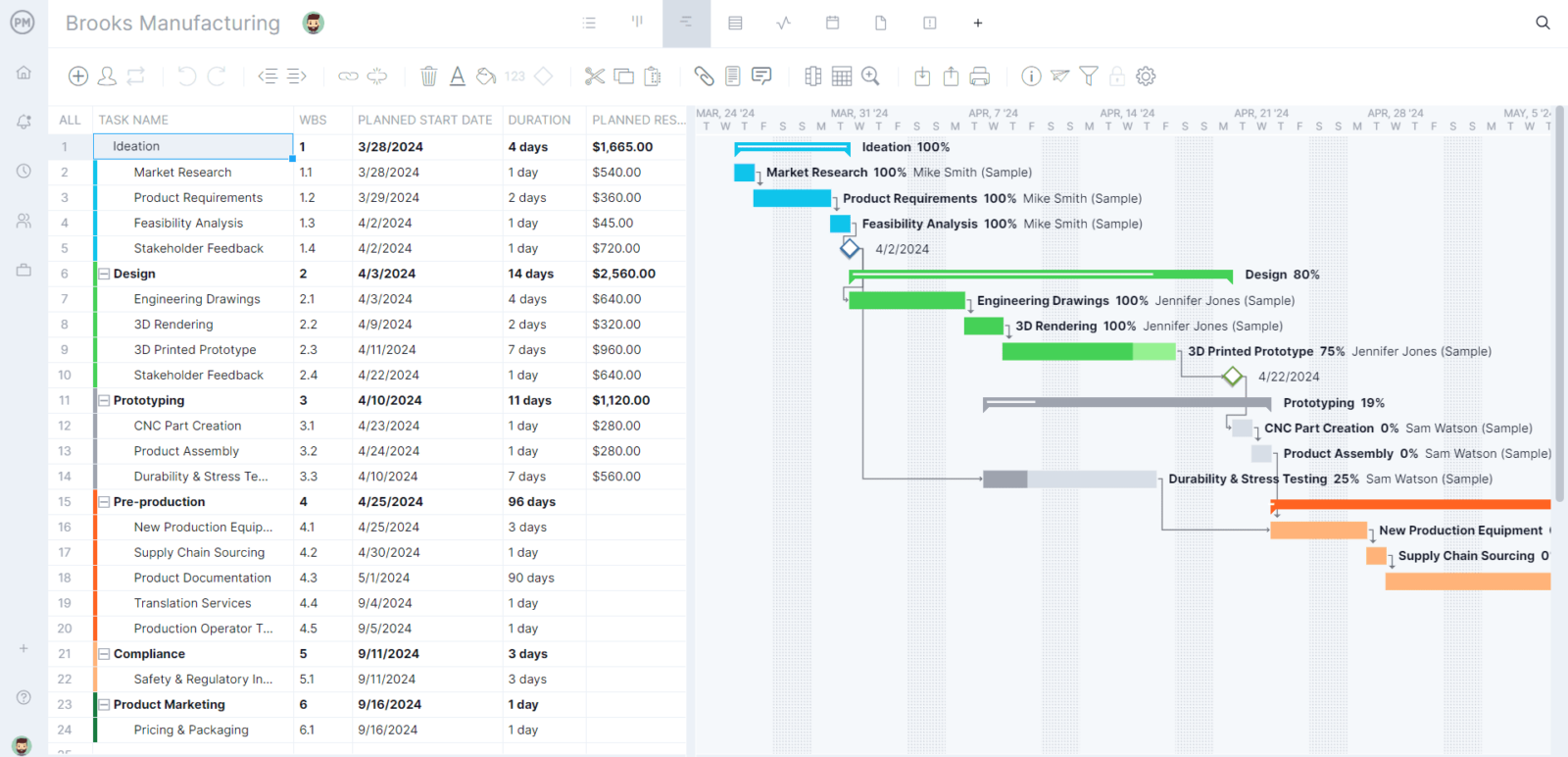
Keep Stakeholders on the Same Page
Keeping stakeholders abreast of progress is key to a successful project. We have many ways to communicate with your stakeholders, such as the real-time dashboard, which automatically crunches project metrics into colorful graphs and charts that are easy to share. You can also share reports, which go into greater detail. They can also be filtered to show just the information stakeholders ask for.
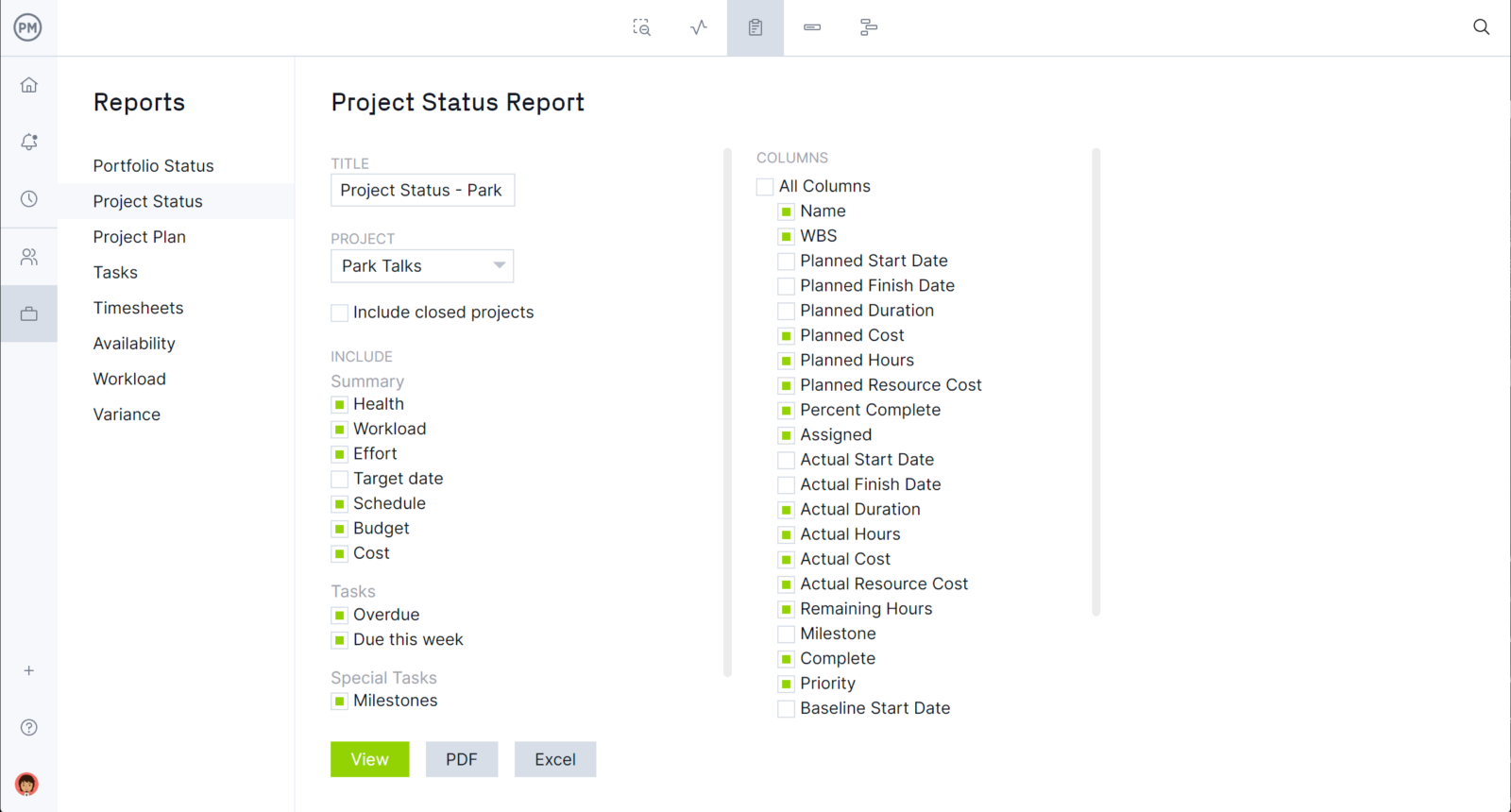
All in One Place
Why use more than one tool to manage your project and stakeholders? ProjectManager has features that manage your project cycle, help you plan, monitor and report, while also giving teams collaborative tools. We have features for resource management and more. It’s all in one place, so don’t sweat it.
ProjectManager is online project management platform with the features that help manage the project cycle. From real-time data to reporting that can be filtered to reflect what you want and shared easily, see how ProjectManager can help your project by taking this free 30-day trial.

